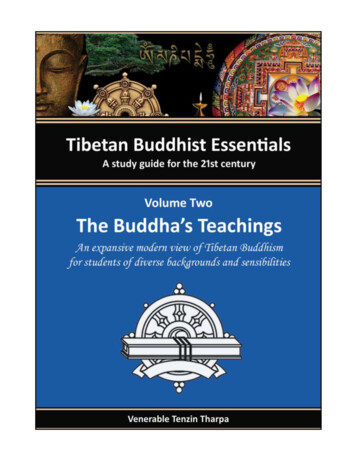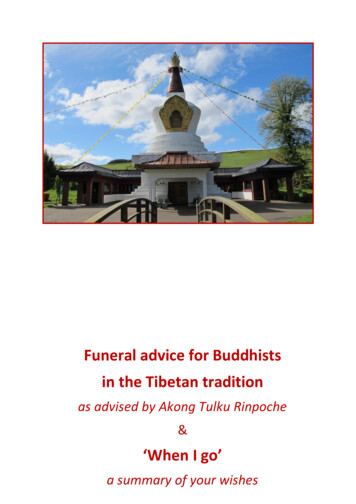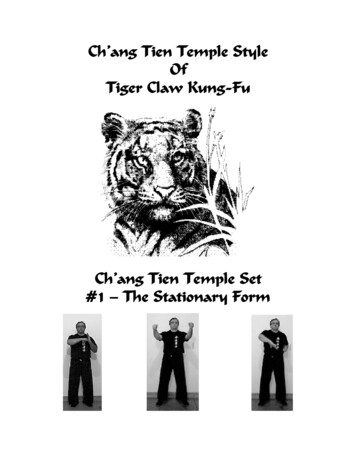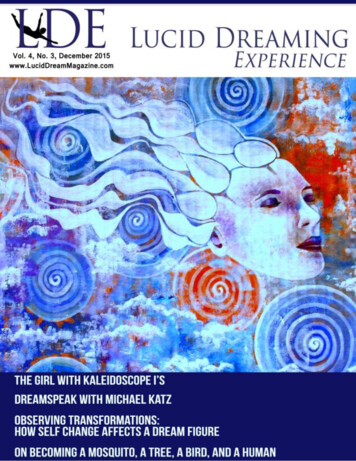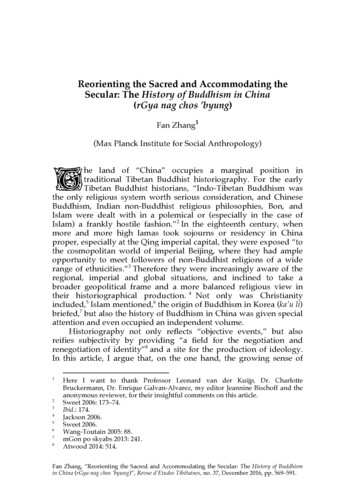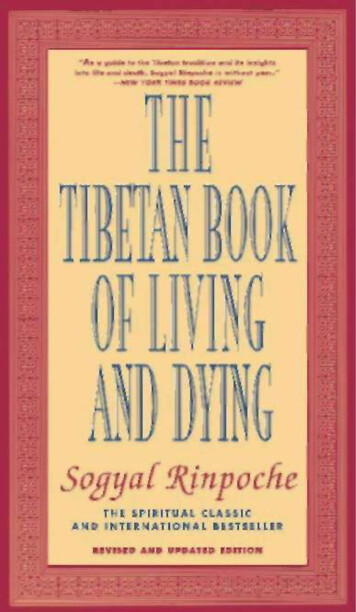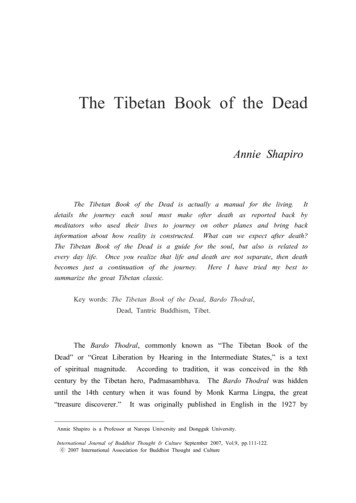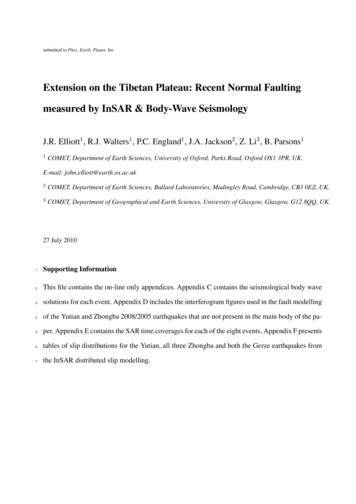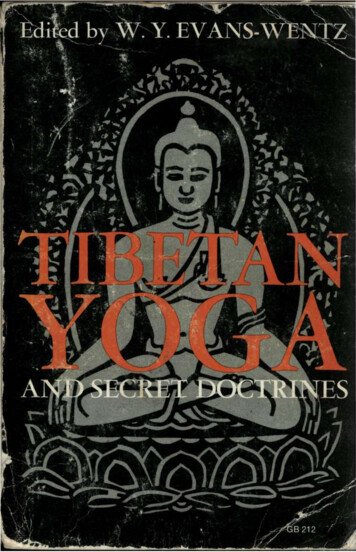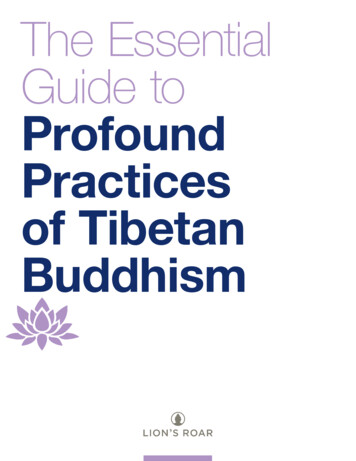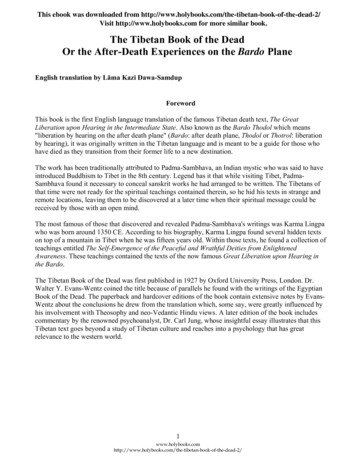
Transcription
This ebook was downloaded from ead-2/Visit http://www.holybooks.com for more similar book.The Tibetan Book of the DeadOr the After-Death Experiences on the Bardo PlaneEnglish translation by Lāma Kazi Dawa-SamdupForewordThis book is the first English language translation of the famous Tibetan death text, The GreatLiberation upon Hearing in the Intermediate State. Also known as the Bardo Thodol which means"liberation by hearing on the after death plane" (Bardo: after death plane, Thodol or Thotrol: liberationby hearing), it was originally written in the Tibetan language and is meant to be a guide for those whohave died as they transition from their former life to a new destination.The work has been traditionally attributed to Padma-Sambhava, an Indian mystic who was said to haveintroduced Buddhism to Tibet in the 8th century. Legend has it that while visiting Tibet, PadmaSambhava found it necessary to conceal sanskrit works he had arranged to be written. The Tibetans ofthat time were not ready for the spiritual teachings contained therein, so he hid his texts in strange andremote locations, leaving them to be discovered at a later time when their spiritual message could bereceived by those with an open mind.The most famous of those that discovered and revealed Padma-Sambhava's writings was Karma Lingpawho was born around 1350 CE. According to his biography, Karma Lingpa found several hidden textson top of a mountain in Tibet when he was fifteen years old. Within those texts, he found a collection ofteachings entitled The Self-Emergence of the Peaceful and Wrathful Deities from EnlightenedAwareness. These teachings contained the texts of the now famous Great Liberation upon Hearing inthe Bardo.The Tibetan Book of the Dead was first published in 1927 by Oxford University Press, London. Dr.Walter Y. Evans-Wentz coined the title because of parallels he found with the writings of the EgyptianBook of the Dead. The paperback and hardcover editions of the book contain extensive notes by EvansWentz about the conclusions he drew from the translation which, some say, were greatly influenced byhis involvement with Theosophy and neo-Vedantic Hindu views. A later edition of the book includescommentary by the renowned psychoanalyst, Dr. Carl Jung, whose insightful essay illustrates that thisTibetan text goes beyond a study of Tibetan culture and reaches into a psychology that has greatrelevance to the western he-tibetan-book-of-the-dead-2/
Book IThe Chikhai Bardo and the Chönyid Bardo]Herein lieth the setting-face-to-face to the reality in the intermediate state: the great deliverance byhearing while on the after-death plane, from 'The Profound Doctrine of the Emancipating of theConsciousness by Meditation Upon the Peaceful and Wrathful Deities'[The Obeisances]To the Divine Body of Truth, the Incomprehensible, Bound-less Light;To the Divine Body of Perfect Endowment, Who are the Lotus and the Peaceful and the WrathfulDeities;To the Lotus-born Incarnation, Padma Sambhava, Who is the Protector of all sentient beings;To the Gurus, the Three Bodies, obeisance.[The Introduction]This Great Doctrine of Liberation by Hearing, which conferreth spiritual freedom on devotees ofordinary wit while in the Intermediate State, hath three divisions: the preliminaries, the subject-matter,and the conclusion.At first, the preliminaries, The Guide Series, for emancipating beings, should be mastered by practice.[The Transference of the Consciousness-Principle]By The Guide, the highest intellects ought most certainly to be liberated; but should they not beliberated, then while in the Intermediate State of the Moments of Death they should practice theTransference, which giveth automatic liberation by one's merely remembering it.Devotees of ordinary wit ought most certainly to be freed thereby; but should they not be freed, then,while in the Intermediate State [during the experiencing] of Reality, they should persevere in thelistening to this Great Doctrine of Liberation by Hearing.Accordingly, the devotee should at first examine the symptoms of death as they gradually appear [inhis dying body], following Self-Liberation [by Observing the] Characteristics [of the] Symptoms ofDeath. Then, when all the symptoms of death are complete [he should] apply the Transference, whichconferreth liberation by merely remembering [the m/the-tibetan-book-of-the-dead-2/
[The Reading of this Thödol]If the Transference hath been effectually employed, there is no need to read this Thödol; but if theTransference hath not been effectually employed, then this Thödol is to be read, correctly anddistinctly, near the dead body.If there be no corpse, then the bed or the seat to which the deceased had been accustomed should beoccupied [by the reader], who ought to expound the power of the Truth. Then, summoning the spirit[of the deceased], imagine it to be present there listening, and read. During this time no relative or fondmate should be allowed to weep or to wail, as such is not good [for the deceased]; so restrain them.If the body be present, just when the expiration hath ceased, either a lāma [who hath been as a guru tothe deceased], or a brother in the Faith whom the deceased trusted, or a friend for whom the deceasedhad great affection, putting the lips close to the ear [of the body] without actually touching it, shouldread this Great Thödol.[The Practical Application of this Thödol by the Officiant]Now for the explaining of the Thödol itself:If thou canst gather together a grand offering, offer it in worship of the Trinity. If such cannot be done,then arrange whatever can be gathered together as objects on which thou canst concentrate thythoughts and mentally create as illimitable an offering as possible and worship.Then the 'Path of Good Wishes Invoking the Aid of the Buddhas and Bodhisattvas' should be recitedseven times or thrice.After that, the 'Path of Good Wishes Giving Protection from Fear in the Bardo', and the 'Path of GoodWishes for Safe Delivery from the Dangerous Pitfalls of the Bardo', it together with the 'Root Wordsof the Bardo', are to be read distinctly and with the proper intonation.Then this Great Thödol is to be read either seven times or thrice, according to the occasion. [Firstcometh] the setting-face-to-face [to the symptoms of death] as they occur during the moments of death;[second] the application of the great vivid reminder, the setting-face-to-face to Reality while in theIntermediate State; and third, the methods of closing the doors of the womb while in the IntermediateState when seeking /the-tibetan-book-of-the-dead-2/
The Chikhai Bardo and the Chönyid Bardo The ObeisancesThe Introduction- The Transference of the Consciousness-Principle- The Reading Of This Thödol- The Practical Application of this Thödol by the Officiant· Part I ·The Bardo of the Moments of Death Instructions on the Symptoms of Death, or the First Stage of the Chikhai Bardo: ThePrimary Clear Light Seen at the Moment of DeathInstructions Concerning the Second Stage of the Chikhai Bardo: The Secondary ClearLight Seen Immediately After Death· Part II ·The Bardo of the Experiencing of Reality Introductory Instructions Concerning the Experiencing of Reality During the Third Stageof the Bardo, Called the Chönyid Bardo, when the Karmic Apparitions AppearThe Dawning of the Peaceful Deities, from the First to the Seventh Day- The First Day- The Second Day- The Third Day- The Fourth Day- The Fifth Day- The Sixth Day- The Seventh DayThe Dawning of the Wrathful Deities, from the Eight to the Fourteenth Day- Introduction- The Eighth Day- The Ninth Day- The Tenth Day- The Eleventh Day- The Twelfth Day- The Thirteenth Day- The Fourteenth DayThe Conclusion, Showing the Fundamental Importance of the Bardo Teachings· Book II ·The Sidpa Bardo The ObeisancesIntroductory Verses· Part I ·The After-Death e-tibetan-book-of-the-dead-2/
The Bardo Body: Its Birth and Its Supernormal FacultiesCharacteristics of Existence in the Intermediate StateThe JudgementThe All-Determining Influence of ThoughtThe Dawning of the Lights of the Six Lokas· Part II ·The Process of Rebirth The Closing of the Door of the Womb- Method of Preventing Entry into a Womb- The First Method of Closing the Womb-Door- The Second Method of Closing the Womb-Door- The Third Method of Closing the Womb-Door- The Fourth Method of Closing the Womb-Door- The Fifth Method of Closing the Womb-DoorThe Choosing of the Womb-Door- The Premonitory Visions of the Place of Rebirth- The Protection Against the Tormenting FuriesThe Alternative Choosing: Supernormal Birth; or Womb-Birth- Supernormal Birth by Transference to a Paradise Realm- Womb-Birth: The Return to the Human WorldThe General Conclusion· The Appendix ·I.II.III.IV.V.The Invocation of the Buddhas and Bodhisattvas'The Path of Good Wishes for Saving from the Dangerous Narrow Passageway of theBardo''The Root Verses of the Six Bardos''The Path of Good Wishes which Protecteth from Fear in the Bardo'The /the-tibetan-book-of-the-dead-2/
Part I[The Bardo of the Moments of Death][Instructions on the Symptoms of Death, or the First Stage of the Chikhai Bardo: The PrimaryClear Light Seen at the Moment of Death]The first, the setting-face-to-face with the Clear Light, during the Intermediate State of the Moments ofDeath, is:Here [some there may be] who have listened much [to religious instructions] yet not recognized; and[some] who, though recognizing, are, nevertheless, weak in familiarity. But all classes of individualswho have received the practical teachings [called] Guides will, if this be applied to them, be set face toface with the fundamental Clear Light; and, without any Intermediate State, they will obtain theUnborn Dharma-Kāya, by the Great Perpendicular Path.The manner of application is:It is best if the guru from whom the deceased received guiding instructions can be had; but if the gurucannot be obtained, then a brother of the Faith; or if the latter is also unobtainable, then a learned manof the same Faith; or, should all these be unobtainable, then a person who can read correctly anddistinctly ought to read this many times over. Thereby [the deceased] will be put in mind of what hehad [previously] heard of the setting-face-to-face and will at once come to recognize that FundamentalLight and undoubtedly obtain Liberation.As regards the time for the application [of these instructions]:When the expiration bath ceased, the vital-force will have sunk into the nerve-centre of Wisdom andthe Knower will be experiencing the Clear Light of the natural condition. Then, the vital-force, beingthrown backwards and flying downwards through the right and left nerves, the Intermediate Statemomentarily dawns.The above [directions] should be applied before [the vital-force hath] rushed into the left nerve [afterfirst having traversed the navel nerve-centre].The time [ordinarily necessary for this motion of the vital-force] is as long as the inspiration is stillpresent, or about the time required for eating a meal.Then the manner of the application [of the instructions] is:When the breathing is about to cease, it is best if the Transference hath been applied efficiently; if [theapplication] hath been inefficient, then [address the deceased] thus:O nobly-born (so and so by name), the time hath now come for thee to seek the Path [in reality]. Thybreathing is about to cease. Thy guru hath set thee face to face before with the Clear Light; and tibetan-book-of-the-dead-2/
thou art about to experience it in its Reality in the Bardo state, wherein all things are like the void andcloudless sky, and the naked, spotless intellect is like unto a transparent vacuum without circumferenceor centre. At this moment, know thou thyself; and abide in that state. I, too, at this time, am setting theeface to face.Having read this, repeat it many times in the ear of the person dying, even before the expiration hathceased, so as to impress it on the mind [of the dying one].If the expiration is about to cease, turn the dying one over on the right side, which posture is called the'Lying Posture of a Lion'. The throbbing of the arteries [on the right and left side of the throat] is to bepressed.If the person dying be disposed to sleep, or if the sleeping state advances, that should be arrested, andthe arteries pressed gently but firmly. Thereby the vital-force will not be able to return from themedian-nerve and will be sure to pass out through the Brahmanic aperture. Now the real setting-faceto-face is to be applied.At this moment, the first [glimpsing] of the Bardo of the Clear Light of Reality, which is the InfallibleMind of the Dharma-Kāya, is experienced by all sentient beings.The interval between the cessation of the expiration and the cessation of the inspiration is the timeduring which the vital-force remaineth in the median-nerve.The common people call this the state wherein the consciousness-principle hath fainted away. Theduration of this state is uncertain. [It dependeth] upon the constitution, good or bad, and [the state of]the nerves and vital-force. In those who have had even a little practical experience of the firm, tranquilstate of dhyāna, and in those who have sound nerves, this state continueth for a long time.In the setting-face-to-face, the repetition [of the above address to the deceased] is to be persisted inuntil a yellowish liquid beginneth to appear from the various apertures of the bodily organs [of thedeceased].In those who have led an evil life, and in those of unsound nerves, the above state endureth only solong as would take to snap a finger. Again, in some, it endureth as long as the time taken for the eatingof a meal.In various Tantras it is said that this state of swoon endureth for about three and one-half days. Mostother [religious treatises] say for four days; and that this setting-face-to-face with the Clear Light oughtto be persevered in [during the whole time].The manner of applying [these directions] is:If [when dying] one be by one's own self capable [of diagnosing the symptoms of death], use [of theknowledge] should have been made ere this. If [the dying person be] unable to do so, then either theguru, or a shishya, or a brother in the Faith with whom the one [dying] was very intimate, should bekept at hand, who will vividly impress upon the one [dying] the symptoms [of death] as they appear indue order [repeatedly saying, at first] e-tibetan-book-of-the-dead-2/
Now the symptoms of earth sinking into water are come.When all the symptoms [of death] are about to be completed, then enjoin upon [the one dying] thisresolution, speaking in a low tone of voice in the ear:O nobly-born (or, if it be a priest, O Venerable Sir), let not thy mind be distracted.If it be a brother [in the Faith], or some other person, then call him by name, and [say] thus:O nobly-born, that which is called death being come to thee now, resolve thus: 'O this now is the hourof death. By taking advantage of this death, I will so act, for the good of all sentient beings, peoplingthe illimitable expanse of the heavens, as to obtain the Perfect Buddhahood, by resolving on love andcompassion towards [them, and by directing my entire effort to] the Sole Perfection.'Shaping the thoughts thus, especially at this time when the Dharma-Kāya of Clear Light [in the state]after death can be realized for the benefit of all sentient beings, know that thou art in that state; [andresolve] that thou wilt obtain the best boon of the State of the Great Symbol, in which thou art, [asfollows]:'Even if I cannot realize it, yet will I know this Bardo, and, mastering the Great Body of Union inBardo, will appear in whatever [shape] will benefit [all beings] whomsoever: I will serve all sentientbeings, infinite in number as are the limits of the sky.'Keeping thyself unseparated from this resolution, thou shouldst try to remember whatever devotionalpractices thou went accustomed to perform during thy lifetime.In saying this, the reader shall put his lips close to the ear, and shall repeat it distinctly, clearlyimpressing it upon the dying person so as to prevent his mind from wandering even for a moment.After the expiration hath completely ceased, press the nerve of sleep firmly; and, a lāma, or a personhigher or more learned than thyself, impress in these words, thus:Reverend Sir, now that thou art experiencing the Fundamental Clear Light, try to abide in that statewhich now thou art experiencing.And also in the case of any other person the reader shall set him face-to-face thus:O nobly-born (so-and-so), listen. Now thou art experiencing the Radiance of the Clear Light of PureReality. Recognize it. O nobly-born, thy present intellect, in real nature void, not formed into anythingas regards characteristics or colour, naturally void, is the very Reality, the All-Good.Thine own intellect, which is now voidness, yet not to be regarded as of the voidness of nothingness,but as being the intellect itself, unobstructed, shining, thrilling, and blissful, is the very consciousness,the All-good Buddha.Thine own consciousness, not formed into anything, in reality void, and the intellect, shining andblissful, -- these two, -- are inseparable. The union of them is the Dharma-Kāya state of holybooks.com/the-tibetan-book-of-the-dead-2/
Thine own consciousness, shining, void, and inseparable from the Great Body of Radiance, hath nobirth, nor death, and is the Immutable Light -- Buddha Amitābha.Knowing this is sufficient. Recognizing the voidness of thine own intellect to be Buddhahood, andlooking upon it as being thine own consciousness, is to keep thyself in the [state of the] divine mind ofthe Buddha.Repeat this distinctly and clearly three or [even] seven times. That will recall to the mind [of the dyingone] the former [i.e. when living] setting-face-to-face by the guru. Secondly, it will cause the nakedconsciousness to be recognized as the Clear Light; and, thirdly, recognizing one's own self [thus], onebecometh permanently united with the Dharma-Kāya and Liberation will be certain.[Instructions Concerning the Second Stage of the Chikhai Bardo: The Secondary Clear LightSeen Immediately After Death]Thus the primary Clear Light is recognized and Liberation attained. But if it be feared that the primaryClear Light hath not been recognized, then [it can certainly be assumed] there is dawning [upon thedeceased] that called the secondary Clear Light, which dawneth in somewhat more than a meal-timeperiod after that the expiration hath ceased.According to one's good or bad karma, the vital-force floweth down into either the right or left nerveand goeth out through any of the apertures [of the body]. Then cometh a lucid condition of the mind.To say that the state [of the primary Clear Light] endureth for a meal-time period [would depend upon]the good or bad condition of the nerves and also whether there hath been previous practice or not [inthe setting-face-to-face].When the consciousness-principle getteth outside [the body, it sayeth to itself], 'Am I dead, or am I notdead ?' It cannot determine. It seeth its relatives and connexions as it had been used to seeing thembefore. It even heareth the wailings. The terrifying karmic illusions have not yet dawned. Nor have thefrightful apparitions or experiences caused by the Lords of Death yet come.During this interval, the directions are to be applied [by the lāma or reader]:There are those [devotees] of the perfected stage and of the visualizing stage. If it be one who was inthe perfected stage, then call him thrice by name and repeat over and over again the above instructionsof setting-face-to-face with the Clear Light. If it be one who was in the visualizing stage, then read outto him the introductory descriptions and the text of the Meditation on his tutelary deity, and then say,O thou of noble-birth, meditate upon thine own tutelary deity. -- [Here the deity's name is to bementioned by the reader.] Do not be distracted. Earnestly concentrate thy mind upon thy tutelary deity.Meditate upon him as if he were the reflection of the moon in water, apparent yet in-existent [in itself].Meditate upon him as if he were a being with a physical body.So saying, [the reader will] impress it.If [the deceased be] of the common folk, -tibetan-book-of-the-dead-2/
Meditate upon the Great Compassionate Lord.By thus being set-face-to-face even those who would not be expected to recognize the Bardo [unaided]are undoubtedly certain to recognize it.Persons who while living had been set face to face [with the Reality] by a guru, yet who have not madethemselves familiar with it, will not be able to recognize the Bardo clearly by themselves. Either aguru or a brother in the Faith will have to impress vividly such persons.There may be even those who have made themselves familiar with the teachings, yet who, because ofthe violence of the disease causing death, may be mentally unable to withstand illusions. For such,also, this instruction is absolutely necessary.Again [there are those] who, although previously familiar with the teachings, have become liable topass into the miserable states of existence, owing to breach of vows or failure to perform essentialobligations honestly. To them, this [instruction] is indispensable.If the first stage of the Bardo path been taken by the forelock, that is best. But if not, by application ofthis distinct recalling [to the deceased], while in the second stage of the Bardo, his intellect isawakened and attaineth liberation.While on the second stage of the Bardo, one's body is of the nature of that called the shining illusorybody.Not knowing whether [he be] dead or not, [a state of] lucidity cometh [to the deceased. If theinstructions be successfully applied to the deceased while he is in that state, then, by the meeting of theMother-Reality and the Offspring-Reality, karma controlleth not. Like the sun's rays, for example,dispelling the darkness, the Clear Light on the Path dispelleth the power of karma.That which is called the second stage of the Bardo dawneth upon the thought-body. The Knower'hovereth within those places to which its activities had been limited. If at this time this special teachingbe applied efficiently, then the purpose will be fulfilled; for the karmic illusions will not have comeyet, and, therefore, he [the deceased] cannot be turned hither and thither [from his aim of www.holybooks.com/the-tibetan-book-of-the-dead-2/
[The Bardo of the Experiencing of Reality][Introductory Instructions Concerning the Experiencing of Reality During the Third Stage of theBardo, Called the Chönyid Bardo, when the Karmic Apparitions Appear]But even though the Primary Clear Light be not recognized, the Clear Light of the second Bardo beingrecognized, Liberation will be attained. If not liberated even by that, then that called the third Bardo orthe Chönyid Bardo dawneth.In this third stage of the Bardo, the karmic illusions come to shine. It is very important that this GreatSetting-face-to-face of the Chönyid Bardo be read: it hath much power and can do much good.About this time [the deceased] can see that the share of food is being set aside, that the body is beingstripped of its garments, that the place of the sleeping-rug is being swept; can hear all the weeping andwailing of his friends and relatives, and, although he can see them and can hear them calling upon him,they cannot hear him calling upon them, so he goeth away displeased.At that time, sounds, lights, and rays -- all three -- are experienced. These awe, frighten, and terrify,and cause much fatigue. At this moment, this setting-face-to-face with the Bardo [during theexperiencing] of Reality is to be applied. Call the deceased by name, and correctly and distinctlyexplain to him, as follows:O nobly-born, listen with full attention, without being distracted: There are six states of Bardo,namely: the natural state of Bardo while in the womb; the Bardo of the dream-state; the Bardo ofecstatic equilibrium, while in deep meditation; the Bardo of the moment of death; the Bardo [duringthe experiencing] of Reality; the Bardo of the inverse process of sangsaric existence. These are the six.O nobly-born, thou wilt experience three Bardos, the Bardo of the moment of death, the Bardo [duringthe experiencing] of Reality, and the Bardo while seeking rebirth. Of these three, up to yesterday, thouhadst experienced the Bardo of the moment of death. Although the Clear Light of Reality dawnedupon thee, thou wert unable to hold on, and so thou hast to wander here. Now henceforth thou artgoing to experience the [other] two, the Chönyid Bardo and the Sidpa Bardo.Thou wilt pay undistracted attention to that with which I am about to set thee face to face, and hold on:O nobly-born, that which is called death hath now come. Thou art departing from this world, but thouart not the only one; [death] cometh to all. Do not cling, in fondness and weakness, to this life. Eventhough thou clingest out of weakness, thou hast not the power to remain here. Thou wilt gain nothingmore than wandering in this Sangsāra. Be not attached [to this world]; be not weak. Remember thePrecious m/the-tibetan-book-of-the-dead-2/
O nobly-born, whatever fear and terror may come to thee in the Chönyid Bardo, forget not thesewords; and, bearing their meaning at heart, go forwards: in them lieth the vital secret of recognition.'Alas! when the Uncertain Experiencing of Reality is dawning upon me here,With every thought of fear or terror or awe for all [apparitional appearances] set aside,May I recognize whatever [visions] appear, as the reflections of mine own consciousness;May I know them to be of the nature of apparitions in the Bardo:When at this all-important moment [of opportunity] of achieving a great end,May I not fear the bands of Peaceful and Wrathful [Deities], mine own thought-forms.'Repeat thou these [verses] clearly, and remembering their significance as thou repeatest them, goforwards, [O nobly-born]. Thereby, whatever visions of awe or terror appear, recognition is certain;and forget not this vital secret art lying therein.O nobly-born, when thy body and mind were separating, thou must have experienced a glimpse of thePure Truth, subtle, sparkling, bright, dazzling, glorious, and radiantly awesome, in appearance like amirage moving across a landscape in spring-time in one continuous stream of vibrations. Be notdaunted thereby, nor terrified, nor awed. That is the radiance of thine own true nature.Recognize it.From the midst of that radiance, the natural sound of Reality, reverberating like a thousand thunderssimultaneously sounding, will come. That is the natural sound of thine own real self. Be not dauntedthereby, nor terrified, nor awed.The body which thou hast now is called the thought-body of propensities. Since thou hast not amaterial body of flesh and blood, whatever may come -- sounds, lights, or rays -- are, all three, unableto harm thee: thou art incapable of dying. It is quite sufficient for thee to know that these apparitionsare thine own thought-forms. Recognize this to be the Bardo.O nobly-born, if thou dost not now recognize thine own thought-forms, whatever of meditation or ofdevotions thou mayst have performed while in the human world -- if thou hast not met with thispresent teaching -- the lights will daunt thee, the sounds will awe thee, and the rays will terrify thee.Shouldst thou not know this all-important key to the teachings -- not being able to recognize thesounds, lights, and rays -- thou wilt have to wander in the Sangsāra.[The Dawning of the Peaceful Deities, from the First to the Seventh Day][Assuming that the deceased is karmically bound -- as the average departed one is -- to pass throughthe forty-nine days of the Bardo existence, despite the very frequent settings-face-to-face, the dailytrials and dangers which he must meet and attempt to triumph over, during the first seven days,wherein dawn the Peaceful Deities, are next explained to him in detail; the first day, judging from thetext, being reckoned from the time in which normally he would be expected to wake up to the fact thathe is dead and on the way back to rebirth, or about three and one-half to four days after death.][The First e-tibetan-book-of-the-dead-2/
O nobly-born, thou hast been in a swoon during the last three and one-half days. As soon as thou artrecovered from this swoon, thou wilt have the thought, 'what hath happened!'Act so that thou wilt recognize the Bardo. At that time, all the Sangsāra will be in revolution; and thephenomenal appearances that thou wilt see then will be the radiances and deities. The whole heaveswill appear deep blue.Then, from the Central Realm, called the Spreading Forth of the Seed, the Bhagavān Vairochana,white in colour, and seated upon a lion-throne, bearing an eight-spoked wheel in his hand, andembraced by the Mother of the Space of Heaven, will manifest himself to thee.It is the aggregate of matter resolved into its primordial state which is the blue light.The Wisdom of the Dharma-Dhātu, blue in colour, shining, transparent, glorious, dazzling, from theheart of Vairochana as the Father-Mother, will shoot forth and strike against thee with a light so radiantth
The Tibetan Book of the Dead Or the After-Death Experiences on the Bardo Plane English translation by Lāma Kazi Dawa-Samdup Foreword This book is the first English language translation of the famous Tibetan death text, The
